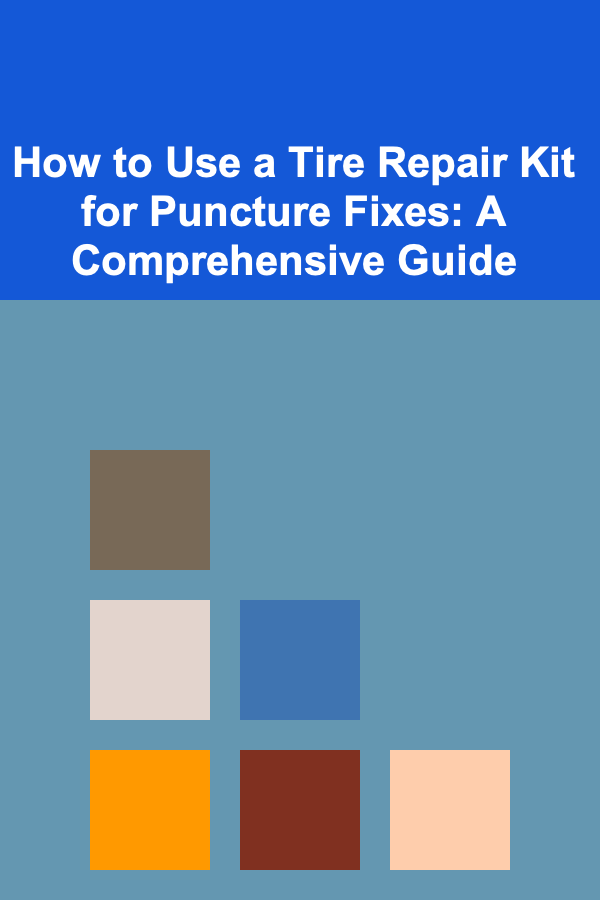
How to Use a Tire Repair Kit for Puncture Fixes: A Comprehensive Guide
ebook include PDF & Audio bundle (Micro Guide)
$12.99$6.99
Limited Time Offer! Order within the next:

A flat tire is an inevitable part of driving. While calling roadside assistance or changing the tire with a spare are common solutions, using a tire repair kit can be a quicker, easier, and often more convenient alternative. Tire repair kits, especially those using tire plugs, can temporarily seal punctures and get you back on the road, allowing you to reach a repair shop for a permanent fix. This comprehensive guide will walk you through the process of using a tire repair kit, covering everything from safety precautions to step-by-step instructions and important considerations for a successful and safe repair.
Understanding Tire Repair Kits
Before diving into the repair process, it's crucial to understand the different types of tire repair kits and their limitations. While there are various methods for repairing tires, tire plug kits are the most common and practical for roadside repairs.
Types of Tire Repair Kits
- Tire Plug Kits: These kits use rubberized plugs inserted into the puncture to seal the hole. They typically include a reamer tool (for cleaning and enlarging the hole), an insertion tool (for inserting the plug), rubber cement (or lubricant), and several tire plugs.
- Tire Patch Kits (Internal): These kits are designed for more permanent repairs and typically involve removing the tire from the rim to apply a patch to the inside of the tire. This requires specialized tools and is best left to professionals.
- Tire Sealant (Aerosol): These are temporary solutions that inject sealant into the tire to seal small punctures. While convenient, they are often messy and may not be suitable for all types of punctures. They often require subsequent tire replacement.
This guide will focus primarily on using tire plug kits, as they are the most practical for emergency roadside repairs.
Limitations of Tire Repair Kits
Important: Tire repair kits are intended for temporary repairs only. A tire repaired with a plug should be inspected and professionally repaired or replaced as soon as possible. Driving on a plugged tire for extended periods or at high speeds can be dangerous.
- Puncture Location: Tire plug kits are generally suitable for punctures in the tire tread area only. They should never be used to repair punctures on the tire sidewall, shoulder, or bead. Sidewall damage compromises the structural integrity of the tire and requires replacement.
- Puncture Size and Type: Tire plug kits are designed for small punctures, typically caused by nails, screws, or small pieces of debris. Larger punctures or gashes are beyond the scope of a tire plug repair and require professional attention.
- Tire Condition: If the tire is already worn, damaged, or has low tread depth, repairing it with a plug may not be safe or effective. It's essential to assess the overall condition of the tire before attempting a repair.
Safety Precautions
Safety is paramount when dealing with a flat tire. Before you even think about using a tire repair kit, follow these crucial safety precautions:
- Pull Over to a Safe Location: As soon as you notice a flat tire, safely pull over to the side of the road, away from traffic. Choose a level surface if possible. Turn on your hazard lights to alert other drivers.
- Engage the Parking Brake: Ensure the parking brake is firmly engaged to prevent the vehicle from rolling.
- Use Warning Devices: Place warning triangles or flares behind your vehicle to alert oncoming traffic. The distance at which you place these devices depends on speed and visibility. Consult your local traffic regulations.
- Wear Safety Gear: Wear safety glasses and gloves to protect your eyes and hands during the repair process.
- Never Work Under a Vehicle Supported Only by a Jack: If you need to lift the vehicle, use a jack stand to support it securely. The jack is only for lifting, not for supporting the weight of the vehicle while you work. This is more relevant if you're thinking of removing the tire to inspect the puncture more closely. However, for a plug repair, this shouldn't be necessary.
- Read the Tire Repair Kit Instructions: Familiarize yourself with the instructions provided with your specific tire repair kit before starting the repair. Different kits may have slightly different procedures.
Tools and Materials Needed
Before you begin, make sure you have all the necessary tools and materials readily available. A well-prepared kit will make the repair process much smoother and safer.
- Tire Repair Kit (with plugs, reamer tool, and insertion tool): Ensure the kit is complete and that the plugs are in good condition.
- Pliers or Vice Grips: For removing the object that caused the puncture.
- Utility Knife or Scissors: For trimming the excess plug material after insertion.
- Tire Inflator (Portable Air Compressor or CO2 Inflator): To reinflate the tire after the repair. A 12V portable air compressor that plugs into your car's cigarette lighter is ideal.
- Tire Pressure Gauge: To ensure you inflate the tire to the correct pressure.
- Gloves: To protect your hands.
- Safety Glasses: To protect your eyes.
- Wheel Chocks (Optional): For added safety, especially if working on a slight incline.
- Jack and Lug Wrench (Optional): May be useful for rotating the tire to a more accessible position, but generally not needed for a plug repair done on the vehicle.
- Spray Bottle with Soapy Water (Optional): To check for leaks after the repair.
- Flashlight or Headlamp (Optional): If working in low-light conditions.
Step-by-Step Guide to Using a Tire Repair Kit (Tire Plug Method)
Now, let's proceed with the actual repair process. Follow these step-by-step instructions carefully for a safe and effective puncture repair.
Step 1: Locate the Puncture
Carefully inspect the tire to locate the puncture. Look for nails, screws, or other debris embedded in the tread. If the object is not immediately visible, you can try slowly rotating the tire to get a better view. If still undetected, slightly inflating the tire might help you hear or feel the escaping air. You can also use soapy water sprayed over the tire; bubbles will form at the puncture site.
Step 2: Remove the Object Causing the Puncture
Use pliers or vice grips to carefully remove the object that caused the puncture. Pull it straight out to avoid further damaging the tire. Note the angle of the object, as you'll need to insert the reamer and plug at a similar angle.
Important: Do not remove the object if the tire is completely flat. Removing it may cause the tire to deflate rapidly and make it more difficult to repair. Instead, inflate the tire slightly before removing the object.
Step 3: Prepare the Puncture Hole with the Reamer Tool
The reamer tool, also known as a rasp tool, is used to clean the puncture hole and prepare it for the tire plug. Insert the reamer tool into the puncture hole and push it in and out several times, using a twisting motion. This will enlarge the hole slightly and roughen the edges, creating a better surface for the plug to adhere to. Apply firm, even pressure, following the same angle at which the object was removed.
Tip: Apply some lubricant (such as rubber cement provided in the kit) to the reamer tool to make it easier to insert and remove.
Step 4: Prepare the Tire Plug
Thread the tire plug through the eye of the insertion tool. Make sure the plug is centered and that equal lengths of the plug extend from each side of the tool's eye. Some kits may require you to apply rubber cement to the plug before inserting it. Refer to the instructions that came with your kit.
Step 5: Insert the Tire Plug
Insert the insertion tool (with the plug) into the prepared puncture hole. Push it in firmly until about two-thirds of the plug is inside the tire. Again, maintain the same angle at which the object was removed. Once the insertion tool is fully inserted, twist it 90 degrees and pull it straight out, leaving the tire plug inside the tire. The twisting action helps to secure the plug in place.
Tip: If the insertion tool is difficult to insert, apply some lubricant to the plug.
Step 6: Trim the Excess Plug Material
Use a utility knife or scissors to trim the excess plug material extending from the tire. Leave about ¼ inch to ½ inch of the plug sticking out. The pressure from the inside of the tire will eventually flatten the protruding plug material.
Step 7: Inflate the Tire
Inflate the tire to the recommended pressure specified on the tire sidewall or in your vehicle's owner's manual. Use a portable air compressor or CO2 inflator to add air gradually. Check the pressure frequently with a tire pressure gauge to avoid over-inflation.
Important: Do not over-inflate the tire. Over-inflation can cause the tire to burst, which is extremely dangerous.
Step 8: Check for Leaks
After inflating the tire, check for leaks around the repaired area. You can use a spray bottle filled with soapy water. Spray the soapy water around the plug. If bubbles form, it indicates a leak. If a leak is detected, try inserting another plug or consider using a tire sealant as a temporary measure until you can get the tire professionally repaired or replaced. If no leaks are detected, proceed to the next step.
Step 9: Re-Check Tire Pressure
After driving a short distance (e.g., 5-10 miles), re-check the tire pressure. Tires can lose pressure due to the repair not being perfectly sealed or temperature fluctuations. If the pressure has dropped significantly, reinflate the tire to the correct pressure and re-check for leaks. If the pressure continues to drop rapidly, the plug may not be holding, and you'll need to seek professional assistance.
Step 10: Drive to a Repair Shop
As emphasized earlier, a tire repaired with a plug is a temporary fix. Drive to a tire repair shop as soon as possible for a professional inspection and repair or replacement. Inform the technician that you have used a tire plug repair kit.
Post-Repair Considerations
After the tire is repaired, there are several important considerations to keep in mind:
- Speed Restrictions: Avoid driving at high speeds (above 50 mph or as recommended by the tire repair kit manufacturer) on a plugged tire. The plug may not be able to withstand the stress of high-speed driving.
- Limited Distance: Limit the distance you drive on a plugged tire. The sooner you get the tire professionally repaired or replaced, the safer you will be.
- Regular Tire Pressure Monitoring: Monitor the tire pressure regularly to ensure it remains within the recommended range. A slow leak may develop over time, so it's essential to keep an eye on the pressure.
- Professional Inspection: Have a tire professional inspect the tire for internal damage. The object that caused the puncture may have damaged the tire's internal structure, even if the plug is holding air.
- Consider Tire Replacement: If the tire is significantly damaged, worn, or if the puncture is located near the sidewall, consider replacing the tire altogether. Safety should always be your top priority.
When to Avoid Using a Tire Repair Kit
There are certain situations where using a tire repair kit is not recommended or even dangerous. Here are some scenarios to avoid:
- Sidewall Damage: As mentioned earlier, never attempt to repair a puncture on the tire sidewall, shoulder, or bead. Sidewall damage compromises the structural integrity of the tire and requires replacement.
- Large Punctures or Gashes: Tire plug kits are designed for small punctures only. Large punctures or gashes are beyond the scope of a tire plug repair and require professional attention.
- Multiple Punctures: If the tire has multiple punctures in close proximity, it's best to replace the tire. Repairing multiple punctures can weaken the tire's structure.
- Pre-Existing Damage: If the tire is already worn, damaged, or has low tread depth, repairing it with a plug may not be safe or effective. It's essential to assess the overall condition of the tire before attempting a repair.
- Inner Tube Tires: Tire plug kits are not suitable for tires with inner tubes. Inner tube tires require a different repair method.
Alternatives to Tire Repair Kits
If you are uncomfortable using a tire repair kit or if the puncture is not suitable for a plug repair, consider these alternatives:
- Changing the Tire with a Spare: If you have a spare tire and know how to change it, this is a reliable option. Consult your vehicle's owner's manual for instructions.
- Calling Roadside Assistance: Roadside assistance services can provide assistance with flat tires, including changing the tire or towing the vehicle to a repair shop.
- Using Run-Flat Tires: Some vehicles are equipped with run-flat tires, which allow you to drive a limited distance on a flat tire. Check your vehicle's specifications to see if you have run-flat tires.
Conclusion
Knowing how to use a tire repair kit can be a valuable skill for any driver. It can save you time and money in emergency situations and get you back on the road quickly. However, it's crucial to understand the limitations of tire repair kits and to prioritize safety at all times. Remember that a tire plug is a temporary fix, and it's essential to have the tire professionally inspected and repaired or replaced as soon as possible. By following the steps outlined in this guide and adhering to safety precautions, you can confidently and safely use a tire repair kit to fix a puncture and continue your journey.

Freelancing as a Path: How to Prepare for Alternative Careers
Read More
How to Make Money Online as a Transcriptionist
Read More
How to Use Online Survey Sites to Make Money
Read More
How To Master Your Home's Unique Design Potential
Read More
Grasping the Concept of Identity: A Deep Dive
Read More
10 Tips for Work Planning with a Side Hustle
Read MoreOther Products

Freelancing as a Path: How to Prepare for Alternative Careers
Read More
How to Make Money Online as a Transcriptionist
Read More
How to Use Online Survey Sites to Make Money
Read More
How To Master Your Home's Unique Design Potential
Read More
Grasping the Concept of Identity: A Deep Dive
Read More